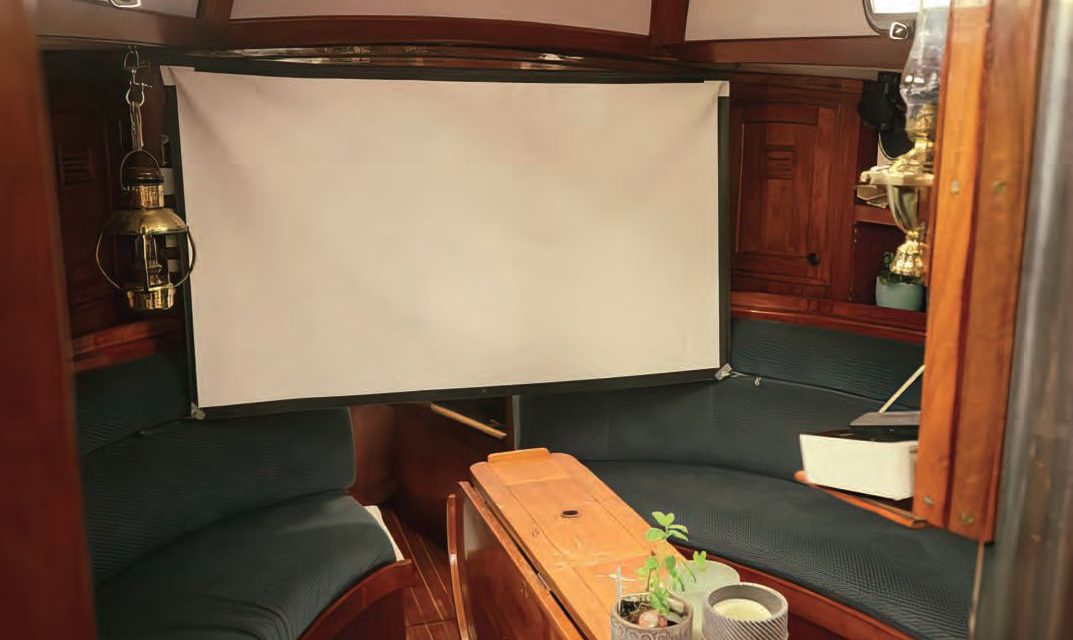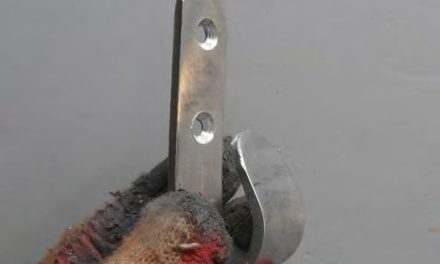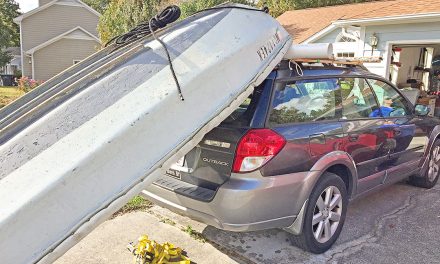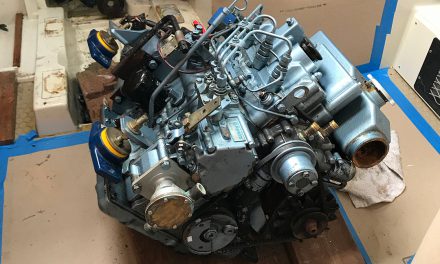A DIY teak box built onto a compression post enables movie-watching in style
Issue 150: May/June 2023
When we bought Avocet in 2018, we knew we were in for a world of projects. From doing a total external refit, rewiring the entire boat, and building our LiFePo4 battery bank to items as small as redoing the upholstery, we have touched nearly every inch of this boat. Yet some of the most impactful projects have been the simplest.
When choosing to live aboard, it may seem like you have to embrace a simple life and leave creature comforts on shore, but that’s not always the case. You weigh what is important to you and welcome aboard most of those things, making room for what you deem necessary — and removing what you don’t. Avocet was fairly comfortable from the outset and offered ample space for our few belongings, but even as proper cinephiles, we could not justify mounting a television aboard, so we found a simple and aesthetically pleasing solution — after a quick modification, of course.
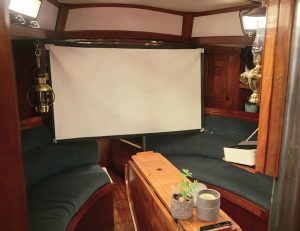
The movie enthusiasts use their mini projector almost every day.
Despite our boat’s carefully thought-out footprint and accommodations, the previous owner had added some of his own touches that didn’t serve us in any way. One of these was a lamp, complete with shade, that my husband deemed “hideous” during our first five minutes aboard. It stuck out like a sore thumb, protruding from the compression post with no real purpose, as the light it emitted was weak and better substituted by the overhead light directly above it. It also used AC power, which meant we wouldn’t be able to use it offshore without sucking a lot of power. Times had changed, and it had to go. But in its absence, what would replace it?
Chris and I researched what other boat owners had done with their compression posts and came across a lot of great ideas, such as wrapping the post with three-strand rope (which our cat, Cleo, would surely love). But after some consideration, we decided to do something unique that would also give our scrap teak a new purpose.
We got to work measuring and sketching out the concept for a teak box that would wrap partially around the compression post, covering the spot where the lamp was once mounted. This was not just a box, though. One of our gimballing oil lamps would be mounted on it, adding a touch of class and ambience, especially when hosting large parties around Avocet’s table, which seats up to 10 comfortably. Even with no additional guests or crew, a romantic, lamplit dinner is always a pleasure. And though having a proper spot for one of our oil lamps would be wonderful, the real star of the project is what would sit inside the box itself.
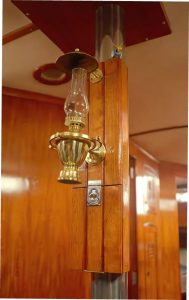
The teak box Chris and Marissa built does double duty, also providing a space to mount an oil lamp.
Beneath the oil lamp, we created a compartment that folds out to hold our pocket projector, which projects onto a stowable screen that hangs on the bulkhead forward of our settees in front of the opening to the V-berth. To make life aboard even better, Chris installed USB outlets directly into our table, which is less than a foot from the compression post, so the projector can plug right into them without any unnecessary extension cords strung about the cabin.
The project took a total of four hours using materials we already had, plus a latch and hinge we purchased for the fold-down door. If you are considering a similar project, here is how we did it:
First, we measured how long our oil lamp was, including the smoke cap, then measured what we thought would be a suitable door to accommodate our roughly 7-inch-long projector. With these two measurements, Chris could make sure the box would be long enough to cover the mounting holes left over from the (hideous) lamp, but not too big that it would prevent us from using the compression post as a grabhold while underway.
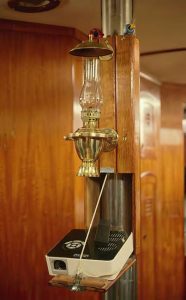
A piece of line holds the door open at the perfect angle for the projector.
Since the compression post was round and we needed to make a box with 90-degree angles, Chris created three wedges that wrapped around the post with semicircle cuts that butted up to the post and flat outside edges that gave us a way to mount the box to the post. He spaced the wedges along the span of the box lengthwise (one each located on the top, bottom, and middle), attaching them by using the threaded holes in the post left over from the old lamp. Then Chris measured for the teak planking that we would use to construct the box and varnish on their outside surfaces.
Using some nice brass countersunk screws, we attached the teak planks to the wedges, giving us the nearly completed box. Then Chris cut the front-facing side of the planks to make a fold-down door for the projector. We connected the three pieces of teak he cut out by attaching two 4-inchlong pieces of teak across them on the top inside edge of the door, which also made a good place for the front of the projector to butt up against when in use. A door is nothing without a hinge and latch, so we visited Mike’s Consignment Shop in Ventura, California, to find a hinge-and-pull type latch that would nicely accentuate our work.
With the pieces needed to finish the job, we mounted the box to the pole, then cracked open a can of our favorite spar varnish, Man O’War, applying seven coats to give the teak a dark and warm honey tone. When the varnish was dry, we installed our oil lamp and used a piece of line to hold the lid of the door at the perfect angle for the projector to display on our screen.
This was one of the very first carpentry projects Chris tackled, and he was armed with only a Harbor Freight hand saw, jigsaw, and Makita drill and impact driver. The simple box was a great way for Chris to cut his literal teeth (saw joke) at woodworking — which he subsequently introduced me to — and set him up for success with the numerous carpentry projects that followed.
In retrospect, we would have either bunged the brass screws or forgone screws entirely, opting instead for a wood glue, which would give the box a more finished look. Additionally, we would have used a router to eliminate the harsh 90-degree angles; that step is now a routine part of our woodworking projects, but at the time it was very foreign to us.
It’s been four years since we installed the projector box, and we use it nearly every day. Although a simple project, it has made a significant impact on our life aboard, ensuring we get to watch our favorite shows in style. Perhaps the best part is that we don’t have any permanently mounted screens or boxes lying about when they are not in use. Everything can be stowed at a moment’s notice, so if the sea is calling, we can pack everything up for safe travels to wherever the wind blows.
Keep your eyes peeled — the Avocet theater might be coming to an anchorage near you. Just follow the smell of popcorn!
Marissa Neely and her husband, Chris, have lived aboard their 1979 Cheoy Lee 41, Avocet, since 2018, preparing to sail the world. They recently cast off their docklines and have been cruising the Pacific coast since 2022. You can follow their adventures on www.svavocet.com and on their YouTube channel, Sailing Avocet.
Thank you to Sailrite Enterprises, Inc., for providing free access to back issues of Good Old Boat through intellectual property rights. Sailrite.com

